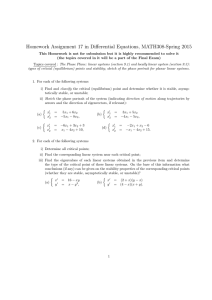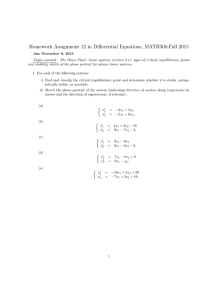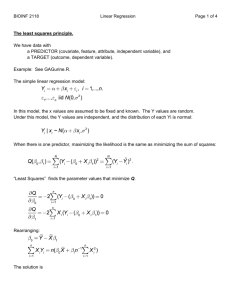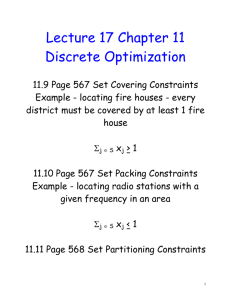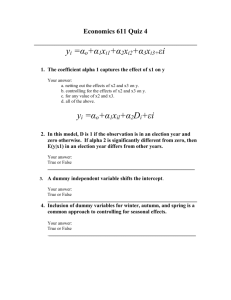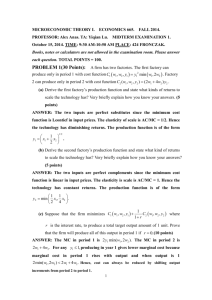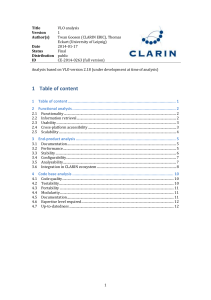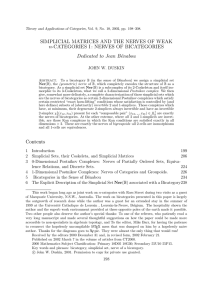Solution to Chapter 1 Analytical Exercises
advertisement
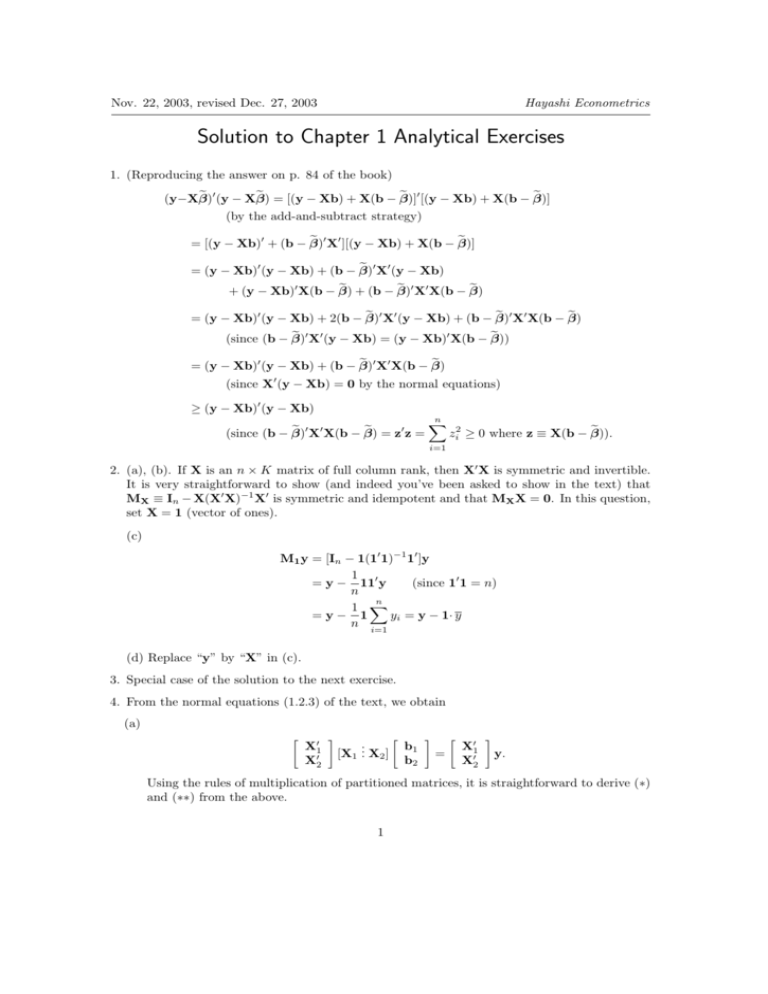
Nov. 22, 2003, revised Dec. 27, 2003 Hayashi Econometrics Solution to Chapter 1 Analytical Exercises 1. (Reproducing the answer on p. 84 of the book) e 0 (y − Xβ) e = [(y − Xb) + X(b − β)] e 0 [(y − Xb) + X(b − β)] e (y−Xβ) (by the add-and-subtract strategy) e 0 X0 ][(y − Xb) + X(b − β)] e = [(y − Xb)0 + (b − β) e 0 X0 (y − Xb) = (y − Xb)0 (y − Xb) + (b − β) e + (b − β) e 0 X0 X(b − β) e + (y − Xb)0 X(b − β) e 0 X0 (y − Xb) + (b − β) e 0 X0 X(b − β) e = (y − Xb)0 (y − Xb) + 2(b − β) e 0 X0 (y − Xb) = (y − Xb)0 X(b − β)) e (since (b − β) e 0 X0 X(b − β) e = (y − Xb)0 (y − Xb) + (b − β) (since X0 (y − Xb) = 0 by the normal equations) ≥ (y − Xb)0 (y − Xb) e 0 X0 X(b − β) e = z0 z = (since (b − β) n X i=1 e zi2 ≥ 0 where z ≡ X(b − β)). 2. (a), (b). If X is an n × K matrix of full column rank, then X0 X is symmetric and invertible. It is very straightforward to show (and indeed you’ve been asked to show in the text) that MX ≡ In − X(X0 X)−1 X0 is symmetric and idempotent and that MX X = 0. In this question, set X = 1 (vector of ones). (c) M1 y = [In − 1(10 1)−1 10 ]y 1 = y − 110 y (since 10 1 = n) n n 1 X =y− 1 yi = y − 1· y n i=1 (d) Replace “y” by “X” in (c). 3. Special case of the solution to the next exercise. 4. From the normal equations (1.2.3) of the text, we obtain (a) X01 X02 . [X1 .. X2 ] b1 b2 = X01 X02 y. Using the rules of multiplication of partitioned matrices, it is straightforward to derive (∗) and (∗∗) from the above. 1 (b) By premultiplying both sides of (∗) in the question by X1 (X01 X1 )−1 , we obtain X1 (X01 X1 )−1 X01 X1 b1 = −X1 (X01 X1 )−1 X01 X2 b2 + X1 (X01 X1 )−1 X01 y ⇔ X1 b1 = −P1 X2 b2 + P1 y Substitution of this into (∗∗) yields X02 (−P1 X2 b2 + P1 y) + X02 X2 b2 = X02 y ⇔ X02 (I − P1 )X2 b2 = X02 (I − P1 )y ⇔ X02 M1 X2 b2 = X02 M1 y ⇔ Therefore, X02 M01 M1 X2 b2 = X02 M01 M1 y e0 X e e 0 e. ⇔ X 2 2 b2 = X2 y (since M1 is symmetric & idempotent) e0 X e −1 X e0 y b2 = ( X 2 2) 2e e e e e0 X (The matrix X 2 2 is invertible because X2 is of full column rank. To see that X2 is of full e column rank, suppose not. Then there exists a non-zero vector c such that X2 c = 0. But e 2 c = X2 c − X1 d where d ≡ (X0 X1 )−1 X0 X2 c. That is, Xπ = 0 for π ≡ −d . This is X 1 1 c .. a contradiction because X = [X1 . X2 ] is of full column rank and π 6= 0.) (c) By premultiplying both sides of y = X1 b1 + X2 b2 + e by M1 , we obtain M1 y = M1 X1 b1 + M1 X2 b2 + M1 e. e ≡ M1 y, the above equation can be rewritten as Since M1 X1 = 0 and y e = M1 X2 b2 + M1 e y e 2 b2 + M1 e. =X M1 e = e because M1 e = (I − P1 )e = e − P1 e = e − X1 (X01 X1 )−1 X01 e =e (since X01 e = 0 by normal equations). (d) From (b), we have e0 X e −1 X e0 y b2 = (X 2 2) 2e 0 −1 0 e X e 2 ) X M0 M1 y = (X 2 2 1 e0 X e −1 X e 0 y. = (X 2 2) 2 e 2 . The residual Therefore, b2 is the OLS coefficient estimator for the regression y on X vector from the regression is e 2 b2 = (y − y e 2 b2 ) e ) + (e y−X y−X e 2 b2 ) = (y − M1 y) + (e y−X = (y − M1 y) + e = P1 y + e. 2 (by (c)) This does not equal e because P1 y is not necessarily zero. The SSR from the regression e 2 can be written as of y on X e 2 b2 )0 (y − X e 2 b2 ) = (P1 y + e)0 (P1 y + e) (y − X = (P1 y)0 (P1 y) + e0 e (since P1 e = X1 (X01 X1 )−1 X01 e = 0). This does not equal e0 e if P1 y is not zero. e 2 b2 + e. So e=X (e) From (c), y e 2 b2 + e)0 (X e 2 b2 + e) e0 y e = (X y 0 e0 X e e 2 e = 0). = b02 X (since X 2 2 b2 + e e e0 X e −1 X e 0 y, we have b0 X e0 e e 0 X2 (X02 M1 X2 )−1 X2 y e. Since b2 = (X 2 2) 2 2 2 X2 b2 = y b e on X1 . Then (f) (i) Let b1 be the OLS coefficient estimator for the regression of y b 1 = (X0 X1 )−1 X0 y b 1 1e = (X01 X1 )−1 X01 M1 y = (X01 X1 )−1 (M1 X1 )0 y =0 (since M1 X1 = 0). b 1 )0 (e b1) = y e0 y e. So SSR1 = (e y − X1 b y − X1 b e 2 equals e by (c), SSR2 = e0 e. e on X (ii) Since the residual vector from the regression of y e on X1 and (iii) From the Frisch-Waugh Theorem, the residuals from the regression of y e 2 ). So SSR3 = e0 e. e (= y e ) on M1 X2 (= X X2 equal those from the regression of M1 y 5. (a) The hint is as good as the answer. b the residuals from the restricted regression. By using the add-and-subtract (b) Let b ε ≡ y−Xβ, strategy, we obtain b = (y − Xb) + X(b − β). b b ε ≡ y − Xβ So b 0 [(y − Xb) + X(b − β)] b SSRR = [(y − Xb) + X(b − β)] b 0 X0 X(b − β) b = (y − Xb)0 (y − Xb) + (b − β) (since X0 (y − Xb) = 0). But SSRU = (y − Xb)0 (y − Xb), so b 0 X0 X(b − β) b SSRR − SSRU = (b − β) = (Rb − r)0 [R(X0 X)−1 R0 ]−1 (Rb − r) = λ0 R(X0 X)−1 R0 λ 0 0 −1 =b ε X(X X) =b ε0 Pb ε. 0 Xb ε b from (a)) (using the expresion for β (using the expresion for λ from (a)) b = R0 λ) (by the first order conditions that X0 (y − Xβ) (c) The F -ratio is defined as F ≡ (Rb − r)0 [R(X0 X)−1 R0 ]−1 (Rb − r)/r s2 3 (where r = #r) (1.4.9) Since (Rb − r)0 [R(X0 X)−1 R0 ]−1 (Rb − r) = SSRR − SSRU as shown above, the F -ratio can be rewritten as (SSRR − SSRU )/r s2 (SSRR − SSRU )/r = e0 e/(n − K) (SSRR − SSRU )/r = SSRU /(n − K) F = Therefore, (1.4.9)=(1.4.11). 6. (a) Unrestricted model: y = Xβ + ε, where y1 1 x12 .. .. .. y = . , X = . . (N ×1) yn (N ×K) 1 xn2 Restricted model: y = Xβ + ε, 0 0 R = . .. ((K−1)×K) . . . x1K .. , .. . . . . . xnK Rβ = r, where 1 0 ... 0 0 1 ... 0 , .. .. . . 0 0 1 β1 β = ... . (K×1) βn 0 r = ... . ((K−1)×1) 0 Obviously, the restricted OLS estimator of β is y y 0 y b = b= β .. . So Xβ .. . . (K×1) 0 y = 1· y. b = (You can use the formula for the unrestricted OLS derived in the previous exercise, β b − (X0 X)−1 R0 [R(X0 X)−1 R0 ]−1 (Rb − r), to verify this.) If SSRU and SSRR are the minimized sums of squared residuals from the unrestricted and restricted models, they are calculated as b 0 (y − Xβ) b = SSRR = (y − Xβ) n X (yi − y)2 i=1 SSRU = (y − Xb)0 (y − Xb) = e0 e = n X e2i i=1 Therefore, SSRR − SSRU = n X i=1 4 (yi − y)2 − n X i=1 e2i . (A) On the other hand, b 0 (X0 X)(b − β) b = (Xb − Xβ) b 0 (Xb − Xβ) b (b − β) n X = (b yi − y)2 . i=1 b 0 (X0 X)(b − β) b (as shown in Exercise 5(b)), Since SSRR − SSRU = (b − β) n n n X X X (yi − y)2 − e2i = (b yi − y)2 . i=1 i=1 (B) i=1 (b) (SSRR − SSRU )/(K − 1) Pn 2 (by Exercise 5(c)) i=1 ei /(n − K) Pn Pn ( i=1 (yi − y)2 − i=1 e2i )/(K − 1) P = (by equation (A) above) n 2 i=1 ei /(n − K) Pn (b y − y)2 /(K − 1) Pn i 2 = i=1 (by equation (B) above) i=1 ei /(n − K) F = P (yb −y) /(K−1) P −y) P e(y/(n−K) P (y −y) n i=1 = = i n i=1 2 i n 2 i=1 i n i i=1 2 (by dividing both numerator & denominator by i=1 2 R2 /(K − 1) (1 − R2 )/(n − K) n X (yi − y)2 ) (by the definition or R2 ). 7. (Reproducing the answer on pp. 84-85 of the book) 0 −1 b b (a) β X)−1 X0 V−1 and b − β GLS − β = Aε where A ≡ (X V GLS = Bε where B ≡ 0 −1 0 0 −1 −1 0 −1 (X X) X − (X V X) X V . So b b Cov(β GLS − β, b − β GLS ) = Cov(Aε, Bε) = A Var(ε)B0 = σ 2 AVB0 . It is straightforward to show that AVB0 = 0. (b) For the choice of H indicated in the hint, −1 0 b − Var(β b Var(β) GLS ) = −CVq C . If C 6= 0, then there exists a nonzero vector z such that C0 z ≡ v 6= 0. For such z, 0 −1 b − Var(β b z0 [Var(β) GLS )]z = −v Vq v < 0 b which is a contradiction because β GLS is efficient. 5 (since Vq is positive definite),
